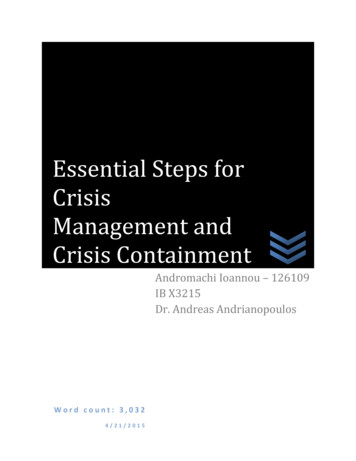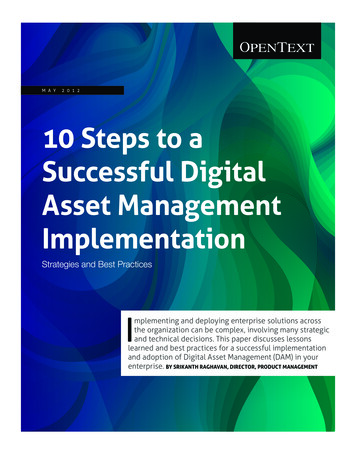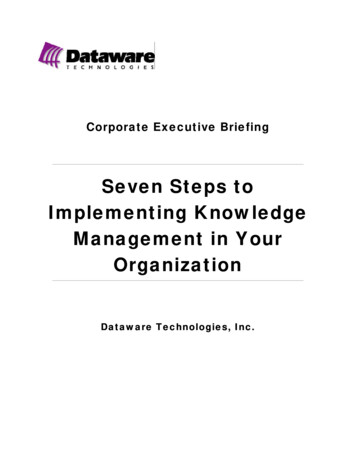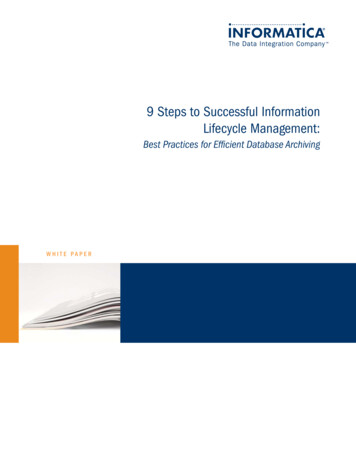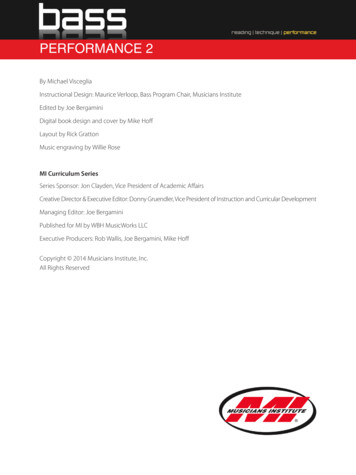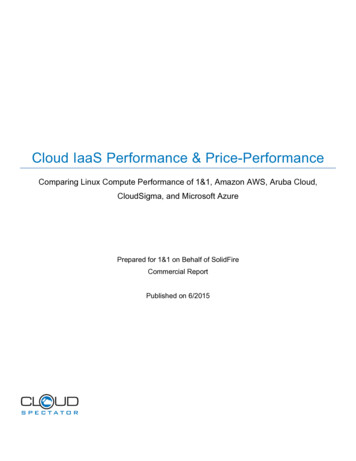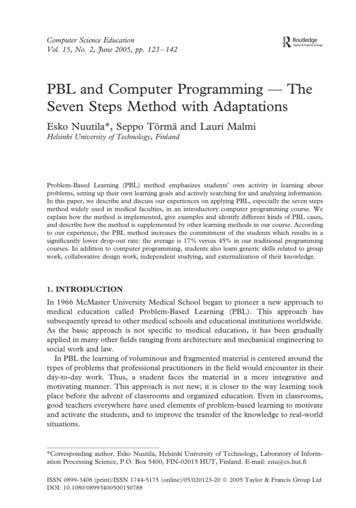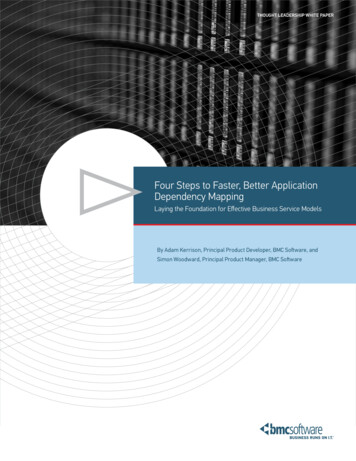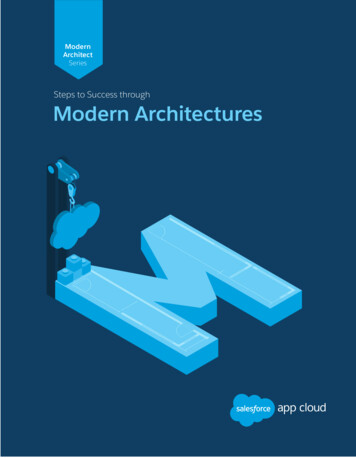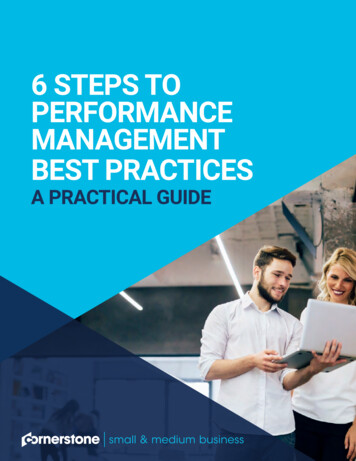
Transcription
6 STEPS TOPERFORMANCEMANAGEMENTBEST PRACTICESA PRACTICAL GUIDE
ContentsEstablishing Effective Performance Management3The Crucial Role of Performance Management5Six Steps to Effective Performance Management7Supporting Effective Performance Management152
Establishing EffectivePerformance ManagementFor many small and medium size businesses (SMBs), finding the time toproactively manage employee performance is difficult. The emphasis is more oftenon increasing revenues and achieving stability, especially in the early days. However,as businesses grow, the need for improving staff engagement, productivity andloyalty becomes increasingly important. It is at this critical stage that PerformanceManagement can mean the difference between businesses that experiencesustained growth and those whose momentum falters.Even when organizations are aware of the importance of Performance Management,the tendency is to carry it out in an ad hoc manner. Such methods work with a lowheadcount, but as this increases, more formal processes are needed.An enormous body of research has shown time and again that consistentemployee feedback plays an important role in the success of larger organizations:“ Over the lastthree decades,extensive surveys ofover 250,000 employees ina huge range of industries aroundthe world have established that keepingemployees happy and committed dependson a few simple practices Research shows thateffective human capital practices can add up to 47%more shareholder value.”Katiyar & Khalid 2014.13
A Practical Guide toPerformance ManagementThis whitepaper offers a practical guide for SMBs that have identifiedPerformance Management as part of their long term growth strategy.Drawing on industry research, client case studies and our extensiveexperience in this field, it offers step by step advice on how to integratePerformance Management into a company’s workflow.We will look at the six steps involved in developing an effective PerformanceManagement strategy:1. Establishing a business case2. Tailoring Performance Management to your specific business needs3. Implementing effective staff reviews4. Building a process that adapts as your business evolves5. Analysing and understanding your strategy’s effectiveness6. Using the most appropriate technology for your companyThese steps are intended to provide insight and clarity to SMBs preparingto implement Performance Management. This paper will identify the majorchallenges SMBs typically face when it comes to introducing PerformanceManagement, and provides practical steps to develop a strategy toovercome them.4
The Crucial Role ofPerformance Management“ It’s great being able to enter goals for employees andbetter manage performance and behavior”Hilary Dempsey, head of HR at TERMINALFOURPerformance Management can be seen as a process which involvescommunicating with employees so that they are aware of what is expected of them,while ensuring that their goals and actions are aligned with company strategy. It isabout effectively managing individuals and teams so as to improve organizationalperformance on a global level. In this way it is strategic (it is about broad issues andlong term goals) and integrated (it links to all aspects of the business).Performance Management can include a range of activities:Learning and trainingTargets for individualsAnnual reviews andregular feedbackDevelopment andimprovement plansObjective rewardsand recognition5
The Chartered Institute of Personnel and Development2 (CIPD) state thatPerformance Management can have considerable business benefits, including: Staff loyalty and empowerment Increased engagement Helping staff progress Customer satisfaction Improved morale Improvements to the bottom lineThere is a misconception that Performance Management simply refers to annualreviews. While these are of course a significant aspect, reviews should be seenas part of a larger process. Rather, Performance Management is a much moreuniversal process. A well-developed strategy will help employees by: Letting them know what the company aims to achieve Communicating the role of individual employees in achieving those aims Arming employees with the skills they need Making them aware of the standards expected of them Letting employees know how they are doing, that they are being supported,how they can develop and manage difficulties2“ Performancemanagement used to besomething companies did topeople, but now people are involvedin their own performance management People like documenting what they have done.”Heather Moore, Employee Development Manager,Vale of Aylsebury Housing Trust6
Steps to Establishing PerformanceManagement Best PracticeIntroducing a Performance Management strategy to your organization is anessential step in achieving organizational maturity. Getting it right can haveconsiderable benefits in terms of business health and staff engagement.Employees benefit considerably when you implement the following stepsand will grow both professionally and personally. As they learn new skills,competencies and recognise the investment the company is making in them,they will become more productive and this will be reflected in the bottom line.Performance Management simply cannot be seen as an ‘optional extra’;organizations which approach company development in an ad hoc manner aresimply less successful. As Onsase et al (2013) research points out:Organizations which do not integrate ongoing performance practices andfeedback into their management development programmes tend to experiencelower than expected performance improvements and higher dissatisfactionand turnover. Thus, performance management provides organizations theopportunity to refine and improve their development activities.3The following challenges and solutions have been identified as the mostimportant steps in developing a Performance Management strategy:7
1Establishing a Business Casefor Performance ManagementWhen introducing the business case for Performance Management, you mayencounter some resistance from senior managers and employees. Typically,colleagues will express concern that: The company lacks time and resources It offers little or no ROI It is an additional control on behaviourCombatting these perceptions will require patience and preparation. It is importantto understand these perspectives but also to challenge them with conviction. Thescience behind Performance Management is solid and you will be able to point toan overwhelming body of research which confirms its effectiveness.In order to overcome these challenges, you need to build a concrete businesscase which outlines the value of introducing Performance Management tothe businesses.“ When PerformanceManagement is donewell, employees becomemore productive, profitable andcreative contributors. Gallup foundthat employees whose managers excel atPerformance Management activities are moreengaged [by up to 70%] than employees whose managersstruggle with these same tasks.”4Gallup, 20158
Solution: Build a solid business caseThe way you construct your business case depends on the culture of yourorganization. However, whether you present the business case as a slideshow or areport, it will need to include the following chapters:ONE. A problem. Identify the key performance challenges facing your organization.Do you have high staff turnover? Are workers regularly underperforming? Isproductivity lacking? Or do you simply need to improve procedures all around?Presenting the business case for Performance Management requires theidentification of a problem and a clear message showing how the process can helpovercome it.TWO. Numbers talk. Analyse the costs and expected outcomes of PerformanceManagement in terms of ROI. Implementing a Performance Management strategywill incur costs, so you need to present a clear idea of what the outcomes will bein relation to the bottom line. Present clear figures outlining exactly how muchthe company can expect to gain and by when. What will a 5% improvement inproductivity mean by the end of the financial year for example?THREE. Involve employees from across the business. Make sure you speak tocolleagues from the ‘shop floor’ up to management in order to include them all onthe Performance Management journey.9
2Tailoring the PerformanceManagement ProcessPerformance Management is not a ‘one size fits all’ process. The actions which work forone organization will be irrelevant to another, so ensuring the process you implement istailored to your business is key.Solution: Carefully designa tailor-made processDeveloping a customised Performance Management process will require considerableknowledge of your company. That said, the fundamental elements of the process will bethe same in any organization:ONE. Research current issues facing the business and review past project initiatives.This is about understanding how Performance Management is currently enacted in thecompany; what are the limits of these and what can be improved?TWO. Talk to managers and colleagues across the organization. Find out what theirmajor issues and needs are. Do they feel there is a lack of fairness in rewards andbonuses? Do they feel they don’t receive enough feedback or guidance? Do they evencare? This should be a litmus test of your whole company, ensure your research isrepresentative of colleagues across the business.THREE. Bring in objective external advisors. Consultants will most likely have seen theproblems your organization faces many times before and can help suggest solutionsyou may never have considered.FOUR. Align Performance Management with organizational goals and strategy byensuring that colleagues’ targets work towards those of the wider business.10
3Implementing EffectiveStaff Reviews“ We can now focus on performance and make sureindividuals are focusing on the right things.”Hilary Dempsey, Head of HR at TERMINALFOUR.The performance review is a major part of Performance Management, and as youdevelop your strategy it is essential to consider how this should be implemented.Good reviews can empower employees and boost their careers, while badlydesigned reviews can affect morale, engagement and performance.Solution: Ensure reviews are effectiveMany businesses take an inappropriate approach to the ‘annual review’. It is oftenseen as stressful by staff, or a pure waste of time. It does not need to be this way,however. The most effective approach to staff reviews should:ONE. Encourage regular feedback throughout the year. What employees discussin their annual review should not be a surprise. Managers need to take the time toregularly let employees know how they are doing in relation to their targets.TWO. Decide on the most effective type of review for your business. The choiceof review and when it is carried out depends on what is most appropriate for yourcompany in terms of time and costs. Types of reviews include: Manager review: line managers provide feedback Self-appraisals: employees rate themselves according to defined targets 360 degree ‘multi-rater’ assessments: A broader review where peers, linemanagers and customers provide feedback to gather a more in-depth viewTHREE. Provide clear outcomes and targets for individuals. This is about aligningbehaviours with wider company goals. Measuring progress against such goalsshould be objective and based on concrete examples and measures so as toensure personal liking or animosity does not come in the way of fairness.11
4Building a Process That Adaptsas Your Business EvolvesThe tools and processes underpinning your Performance Management strategycannot stand still. Just as your company grows and priorities change, so shouldPerformance Management. It might once have been relevant to focus purely onsales figures, yet as a company matures a greater emphasis on brand identityand customer relations is required, and this will engender a related shift in yourPerformance Management strategy.Solution: Have clearly defined roles andprocess documentationThroughout your Performance Management strategy you will need to have anidentifiable project leader. This individual or team will be responsible for thePerformance Management vision in your organization and take a lead on: Constant analysis of how the strategy is being implemented Research into how the company’s Performance Management can be improved Clear documentation of progress“ It’s so wellpresented, intuitive andeasy to use. People reallyenjoy using it. The way the systemis set up means that individuals feelthey have a voice – they write about how theyare progressing and move the slider to where theybelieve they are.”Heather Moore, Learning and Development Adviser,Vale of Aylesbury Housing Trust.12
5Analysing &Understanding ImpactA principal motivation for implementing a Performance Management strategy is that itoffers a means of understanding how individual employees and the organization as awhole are performing against targets. Performance Management will provide you witha rich source of data about colleagues, how they feel, what the major challenges theyface are and areas in which they and the organization could improve. This data shouldbe used to: Define new organizational targets Identify weaknesses and failures Reward success Help discover rising starsSolution: Analyze & use your dataPerformance Management data should, if at all possible, be digitized. This willmassively facilitate your ability to analyze the information you have collectedthroughout the process. Data should be analyzed in relation to company goals: Who is achieving goals, who is surpassing them and who is underperforming? How is morale among colleagues? Where is the company improving and where could it do better? How widespread is understanding of roles and responsibilities? Do staff understand the company’s goals?As with any data, these statistics should inform company policies. They can be used toinform new goals and strategies.13
6Using the Most AppropriateTechnology for Your Company“ The platform we use forms the key piece of our talentmanagement strategy. It’s the tool we go to look at howpeople are performing, what the next challenges are andwhat the training needs are.“Nicola Austin, HR Manager at TectradeCompanies traditionally carried out their Performance Management activities usingpen and paper, with reviews spent filling in tick-box forms. There is a perception,especially among SMBs, that any larger Performance Management tools wouldbe costly and burdensome. However, platforms such as Cornerstone’s PiiQ byCornerstone provide state of the art tools tailored to SMBs.Solution: Use appropriate cloudbased solutionsTechnology for the Performance Management industry has rapidly advancedin recent years and is now an accessible to companies of all sizes. Flexible andscalable, Cloud based subscription services offer some of the best solutions forcompanies by providing: Easy to access online review tools, using browser based technology end usersrecognise. This results in greater completion figures from respondents. Tracking and analysis are simplified, and available across desktop and mobile devices. Automation and streamlining of performance reviews using workflow technologythat integrates with existing Line-Of-Business systems. Catalogues of previous actions and targets are stored securely, backed up, andeasily available for retrieval and review anytime. Training resources can also be made available online, and easily linked toPerformance Management tools. Tips and pre-defined feedback available to managers when writing performanceappraisals, by logging into the same systems with their own credentials.14
Supporting EffectivePerformance ManagementAs this guide has outlined, Performance Management is an essential factor inimproving the outcomes of growing organizations. Contrary to perception, itinvolves far more than simple annual reviews. Instead it is a broader discipline,offering numerous ways of aligning employees’ behaviours with company goals.This paper has outlined the six major steps involved in implementing aneffective Performance Management strategy. These steps can be supported byadopting PiiQ – a performance and learning solution for the growing business.15
References1. Katiyar, Jyoti; Khalid, Anila. 2014. Analysis of role of Performance Management in Humanresource management and measures for its improvement. International Journal of AdvancedResearch in Engineering and Sciences. Issue 1, Volume 1. Page: 4. Available 4/02/NCRTEM-24.pdf2. CIPD http://www.cipd.co.uk3. Onsase, A. et al. 2013. Assessment of the effects of performance management practices onprovision of financial services by savings and credit cooperative societies: the case of GusiiMwalimu Sacco, Kisii Central District, Kenya. P. 503. Available ndex.php/jscp/article/view/850/7614. Harter, Jim; Adkins, Amy. Employees want a lot more from their managers. 2015. Gallup.Available online: yees-lot-managers.aspx?utm source EMPLOYEE ENGAGEMENT&utm medium topic&utm campaign tilesLearn more smb.cornerstoneondemand.comCornerstone is committed to helping small tomedium-sized businesses develop an engagedworkforce to drive higher performance and revenue.smb.cornerstoneondemand.comStay connected:North America Global HQ1601 Cloverfield Blvd.Suite 600 SouthSanta Monica, CA 90404888-365-CSODEurope, Middle East,Africa (EMEA)4 Coleman StreetLondon, EC2R 5AR 44 (0) 203 700 2900Asia Pacific Japan (APJ)Level 1, North29 Union St.Auckland 1010Australia: 61 (2) 8667 3178New Zealand: 64 9 968 2133 2017 Cornerstone OnDemand 888-365-CSOD
Management Best Practice Introducing a Performance Management strategy to your organization is an essential step in achieving organizational maturity. Getting it right can have considerable benefits in t

